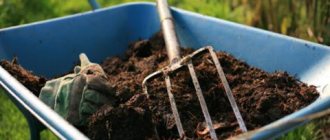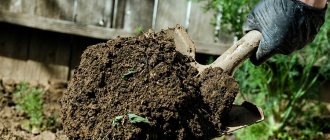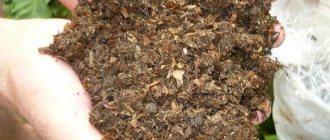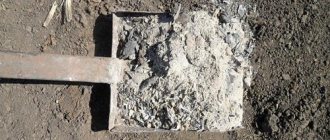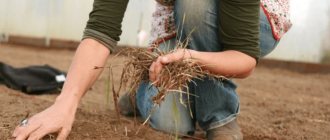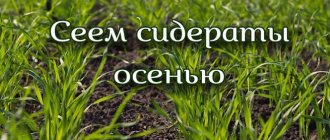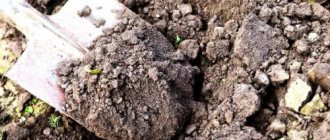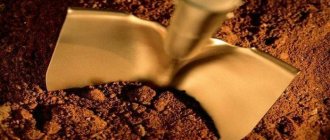It is really necessary to improve the soil in the fall. During this period, you can successfully change its acidity and moisture capacity, loosen it from the inside, and improve fertility. We will tell you what exactly and in what doses to add to the soil for these purposes.
In the fall, it is customary to apply both fertilizers during digging (over the winter they will have time to become part of the organomineral complex of the soil, make it more fertile and will nourish the plants throughout the next season) and soil-improving additives. Which ones and how? Let's talk.
We apply manure in the fall
First of all, in the fall it is worth adding manure to the soil for digging (ploughing). This versatile natural fertilizer is rich in calcium and magnesium, which help reduce soil acidity. Potassium and phosphorus are contained in manure in the most accessible form for plants, and nitrogen remains in the soil for a long time. Microorganisms contained in manure contribute to the formation of humus.
Digging requires approximately 2-3 kg of organic fertilizers per 1 sq.m of sandy soil, and more - 6-8 kg per 1 sq.m of clay soil.
How to apply manure in the fall? It is distributed over the surface of the soil and immediately dug up with soil to the depth of a spade bayonet (15-20 cm). Unlike the spring application of this fertilizer, when the manure must be rotted so that, due to the high content of uric acid and other aggressive substances, it does not burn young plants, fresh manure can be applied in the fall, since there is no longer such a danger. Over the winter, the manure will become saturated with moisture, mix well with the soil and begin to rot. The soil will become more loose and also fertile, since the accumulation of necessary substances in it will occur more actively, and the plants will be fed with microelements of the fertilizer gradually, over the next 6-8 months. Therefore, autumn fertilizing with manure is considered more useful than spring fertilizing. In addition, the weed seeds contained in the manure will sprout earlier after it is applied in the fall.
You can feed fruit trees and shrubs with manure in the fall, or apply it to future garden beds and greenhouses.
- Manure: how to use natural fertilizer to feed plants
Which manure is better, horse, cow or bird manure? All about the beneficial properties of the most effective organic fertilizer is in our article.
Synthetic or natural
After harvesting, it is necessary to prepare the soil for the next season. However, not all summer residents know how to fertilize the soil in the fall if there is no manure? Some people think that it is better to use several complex mixes at once. Some people, on the contrary, recommend using various fertilizers separately. This is the wrong approach. After all, some natural and synthetic additives can lose most of their beneficial properties during the winter.
To use fertilizers correctly, you need to know exactly which ones can be applied to the soil in the fall and which ones should be left until spring. In addition, it should be noted that not all supplements are universal. Some can only be used on trees, while others can only be used on soil intended for planting vegetable crops.
We add peat in the fall
Also, a good option would be to add a soil-improving substance such as peat to the beds in the fall. It has little effect on the saturation of the soil with nutrients (it contains only nitrogen in sufficient quantities, of which plants absorb only 3-5%), but, nevertheless, helps to improve the physical properties of the soil: it makes it looser, warmer, more porous, air- and moisture-permeable. The improving properties of peat are most clearly manifested on poorly cultivated sandy and heavy clay soils.
Only highly decomposed lowland peat is suitable for beds; high-moor and transitional peat are not suitable for these purposes.
If the soil is very heavy or depleted, it is best to apply peat twice - in the fall and in the spring. With autumn digging, add 4-5 kg of peat per 1 sq.m of soil, and in the spring, repeat the application of the same dose and carefully dig the ground again.
- Everything you wanted to know about organic fertilizers
No “chemistry”, only environmentally friendly fertilizers.
Potassium sulfate
Fertilizing the soil in the fall is of particular importance. Calcium sulfate is an additive that is used in combination with phosphorus and nitrogen fertilizers. This preparation is often used to fertilize the soil around gooseberry, currant and raspberry bushes. In addition, the additive is suitable for feeding garden strawberries and strawberries.
Potassium sulfate, which was added to the soil in the fall, allows the shrubs to easily overwinter. At the same time, the survival rate of garden crops increases even during severe frosts. As for dosage, 1 m2 requires no more than 30 grams of fertilizer.
We add humus and compost in the fall
Compost is an affordable and useful fertilizer obtained from food and plant waste. Humus (rotted and decomposed manure or leaf litter) is also a universal remedy for improving the structure of the soil and its properties.
Humus and compost can also be added in both spring and autumn at the rate of 1-2 buckets per 1 sq.m. When applied in the fall, some of the beneficial substances from these fertilizers can be washed away by melt water, but over the winter the organic matter will be saturated with moisture, finally “ripe” and easily mix with the soil, willingly and evenly releasing the rest.
The exception is compost made from wood waste - shavings, bark, branches - which is laid exclusively in the fall when digging up the garden. If you add it to the soil in the spring, the decomposition process will take over the lion's share of nutrients, depriving the plant of them.
- How to make the right compost for feeding plants
Fertilizing the soil is an important part of plant growing activities. And compost is considered one of the leaders in the “world of fertilizing”.
Is it possible to use phosphate rock?
So, what fertilizers are applied to the soil in the fall? This list includes phosphate rock. It is used to feed impoverished soddy-podzolic soils and leached chernozems, which are being prepared for spring liming. This supplement is of natural origin. These are ground rocks.
Many experts recommend applying such fertilizers during digging in the fall along with manure. This promotes better dissolution of phosphorus in the soil. In addition, phosphate rock is not suitable for every plant, since it contains calcium. The main advantage of the supplement is its natural composition. This fertilizer is absolutely safe for humans.
We apply mineral fertilizers in the fall
But not only adding organic matter in the fall is good for the soil. To make it more fertile for the new season, in September-October it is worth remembering about mineral fertilizers for the garden. Phosphorus, potassium and even nitrogen (albeit to a much lesser extent) - all these useful substances will help increase crop yields, extend their fruiting period, support metabolism and withstand adverse weather conditions. In addition, this is a good foundation for next spring, when trees and shrubs are in dire need of nutrients.
The time for applying fertilizers in the fall may differ for different plants; before using additives, familiarize yourself with the agricultural practices of each specific crop.
Mineral fertilizers are usually applied in liquid form (if in dry form, the plants must be watered after application). They should contain phosphorus, potassium and calcium, which strengthen the immunity of plants and increase their resistance to low temperatures. There are many specially selected compositions and mixtures for various crops - these are simple and double superphosphate, potassium sulfate and potassium chloride, potassium nitrate, potassium monophosphate, nitroammophoska, nitrophoska, ammophos... As a rule, such compositions are even marked on the packaging with the appropriate inscription: “autumn” or "autumn".
- Autumn fertilizers - how to feed the garden, vegetable garden and flower garden at the end of the season
We'll tell you how to enrich the soil so that green pets will continue to delight you next year.
What plants is it suitable for?
Thanks to this fertilizing, there is no need to apply additional fertilizing in the spring. This fertilizer is suitable for potatoes. In the fall, compost is distributed throughout the site, and tubers are planted in the spring. Harvest dates are shifted by approximately 2 weeks. It is worth noting that this fertilizer is suitable for all early vegetable crops.
What fertilizers should be applied in the fall for fruit trees? Many people recommend using compost. After all, the garden also needs additional nutrition. It is worth noting that such a substrate is often used to protect the root zone of all fruit trees. To do this, compost is laid in a fairly thick layer around the entire diameter of the trunk. The fertilizer is left here until spring. When the first warm days arrive, the soil around the trunks must be carefully loosened. Thanks to such manipulations, the beneficial components contained in the substrate penetrate deep into the soil and begin to nourish the roots of trees and shrubs.
We add liming additives in the fall
If in your area there is something wrong with the acidity of the soil, in addition to fertilizers, in the fall you should think about introducing substances that regulate it. Fluff lime (slaked lime), dolomite flour, chalk, ash are excellent means for reducing excessive soil acidity, when many nutrients enter a state in which they are no longer absorbed by plants. And the activity of some beneficial bacteria is inhibited.
They are evenly distributed over the soil surface without mixing to depth (dig beds with such additives should only be done on extremely heavy clay and loamy soils). The intervals between adding liming agents should be 1-2 years.
Soil liming is carried out in the fall, because At least several months must pass from the moment the above additives are added to the start of the active growing season of plants so that their growth and development are not disrupted.
- Soil acidity: determine and regulate
If your soil is highly acidic, this can seriously harm your plants. How do you know when it's time to take action?
As you can see, in the fall the soil in the garden and vegetable garden needs your care and attention no less than at the height of the summer season. The garden should be provided with a comfortable and proper “wintering”. Don’t forget to properly take care of the soil in a timely manner, add the necessary substances and prepare it for the new season so that it increases its fertility and repays you with a rich harvest.
Method for determining soil acidity
The most complex but reliable method for determining soil pH is laboratory analysis. The method is expensive and is not used often. In this case, a test kit for determining acidity comes to the rescue, which can be purchased at any relevant store. Testing involves diluting a small amount of soil in distilled water and testing it with litmus paper.
It is possible to determine the general condition of the soil without chemical analysis. Just look at the weeds that grow independently on the site, and everything will immediately become clear. If the soil pH becomes alkaline, weeds such as nettle, clover, and burdock will grow freely on it.
Most garden crops prefer to grow on neutral, so-called “noble” soils, and a too acidic environment is unacceptable if the goal is to harvest a large harvest. The situation can be corrected by applying special fertilizers with a liming effect.
Deoxidation of soil with ash
Ash is an effective soil deacidifier, but not the best. It is better to use ash on soil that requires slight deoxidation. To influence the acidity level to a greater extent, it is necessary to add a lot of ash, and this will lead to the accumulation of too many microelements in the soil. It is safe to say that ash is more of a feeding agent than a deoxidizing agent.
In the event that ash still needs to be used, you should give preference to ash from birch wood. It contains a large amount of phosphorus and potassium. Its norm per square meter is about 10 kg.
